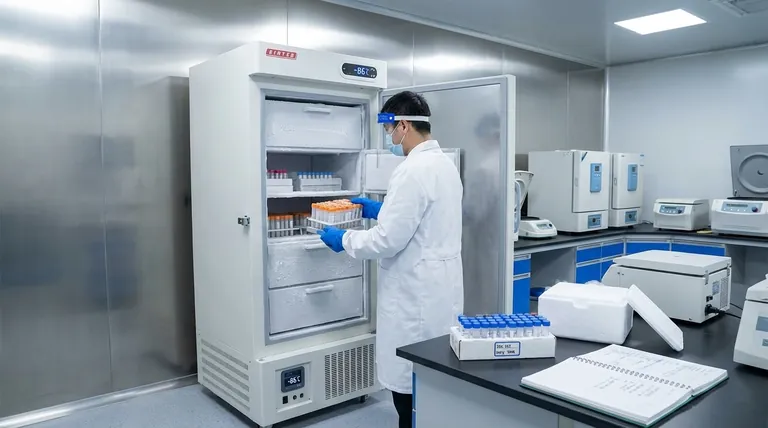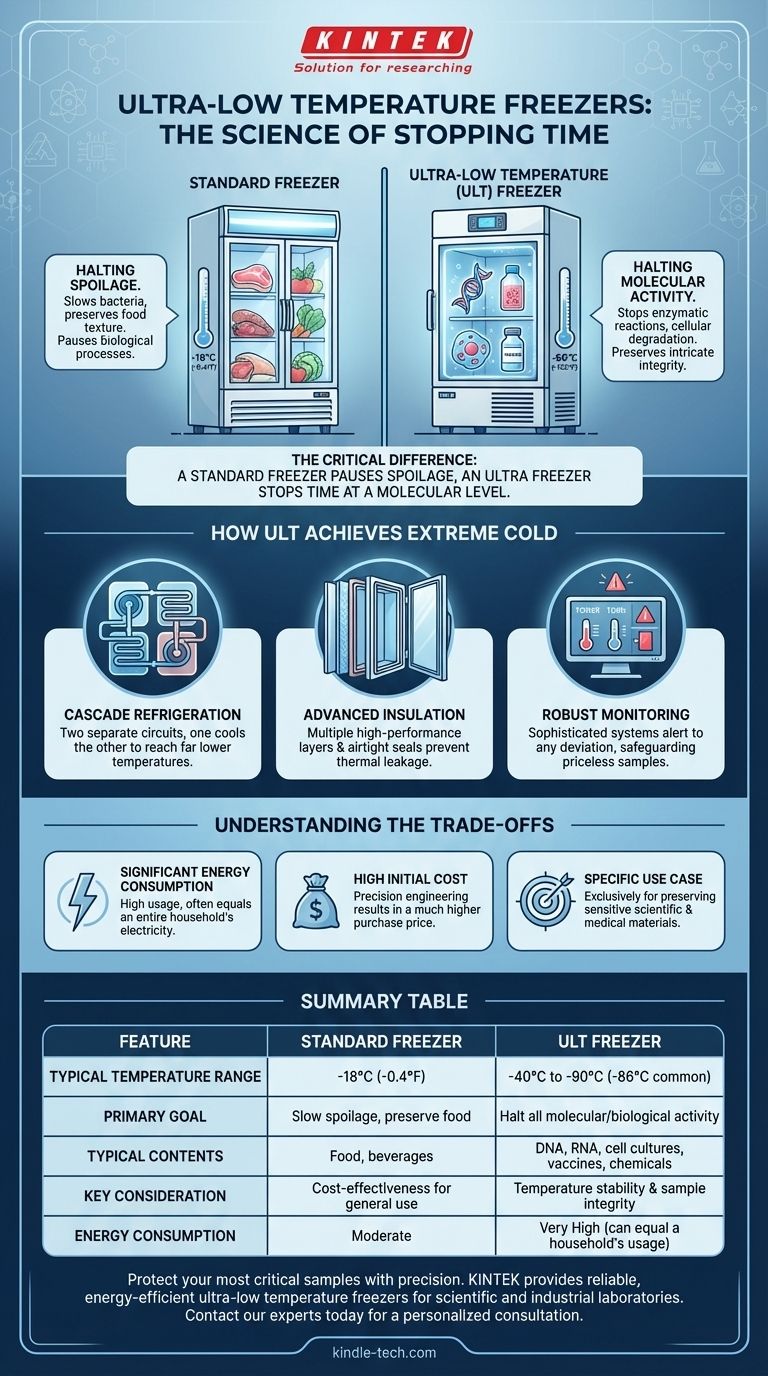An ultra-low temperature (ULT) freezer is a specialized piece of equipment designed to maintain temperatures between -40°C and -90°C. Unlike a common household or commercial freezer that simply slows spoilage, a ULT freezer is engineered to halt virtually all biological and chemical activity within a sample, preserving it for long-term scientific and industrial use.
The fundamental difference isn't just the temperature; it's the purpose. A standard freezer pauses spoilage, but an ultra freezer stops time at a molecular level, preserving the intricate integrity of sensitive biological and chemical materials.

The Critical Difference: Beyond Simple Freezing
To understand the need for a ULT freezer, we must first recognize the different goals of cooling. A standard freezer and a ULT freezer operate on entirely different principles for entirely different reasons.
Standard Freezers: Halting Spoilage
A common freezer, found in a home or restaurant, typically operates around -18°C (-0.4°F). This temperature is effective at slowing the growth of bacteria and microorganisms, which prevents food from spoiling. It freezes water content, preserving the general texture and safety of food for weeks or months.
ULT Freezers: Halting Molecular Activity
An ultra freezer operates in a range where even subtle biological processes stop. At temperatures like -86°C (-122°F), enzymatic reactions and cellular degradation effectively cease. This is critical for preserving sensitive samples like DNA, RNA, viruses, cell cultures, and volatile chemicals whose structures would be destroyed by any residual activity.
The Importance of Stability
ULT freezers are designed to maintain a constant and homogeneous temperature throughout the chamber. Even minor temperature fluctuations can compromise years of research or thousands of dollars worth of materials. For this reason, their performance is measured in their ability to hold a precise temperature without deviation over extended periods.
How ULT Freezers Achieve Extreme Cold
The engineering behind a ULT freezer is fundamentally more complex than that of a standard refrigeration unit. This complexity is necessary to create and maintain such a steep temperature gradient between the inside and the outside.
Specialized Refrigeration Systems
Most ULT freezers use a cascade refrigeration system. This involves two separate refrigeration circuits that work in tandem. The first circuit cools the second, allowing the second circuit to achieve far lower temperatures than a single system ever could.
Advanced Insulation and Sealing
To maintain efficiency and stability, ULT freezers feature multiple layers of high-performance insulation. The doors are built with multiple gaskets and secure latching mechanisms to create an airtight seal, preventing any thermal leakage from the ambient environment.
Robust Monitoring and Alarms
Given the value of their contents, these units are equipped with sophisticated alarm systems. These systems immediately alert personnel to power failures, temperature deviations, or if a door is left ajar, providing a critical safeguard for irreplaceable samples.
Understanding the Trade-offs
While incredibly powerful, ULT freezers are a specialized tool with significant operational considerations.
Significant Energy Consumption
Maintaining a temperature of -86°C requires a tremendous amount of energy. A single ULT freezer can consume as much electricity as an entire average household, making energy efficiency a major factor in their design and selection.
High Initial Cost
ULT freezers are precision scientific instruments. Their complex engineering, robust construction, and specialized components result in a significantly higher purchase price compared to any standard commercial freezer.
Specific Use Case
This technology is not an all-purpose solution. Using a ULT freezer for general-purpose storage would be inefficient, costly, and unnecessary. It is a specific tool built exclusively for the preservation of sensitive scientific and medical materials.
Making the Right Choice for the Task
The choice between a standard and an ultra freezer is dictated entirely by the preservation requirements of the material being stored.
- If your primary focus is food preservation or general cold storage: A standard freezer is the correct, efficient, and cost-effective tool.
- If your primary focus is the long-term viability of sensitive biological or chemical samples: An ultra-low temperature (ULT) freezer is the only option to ensure their molecular integrity.
Ultimately, choosing the right freezer means understanding precisely what you need to protect and for how long.
Summary Table:
| Feature | Standard Freezer | Ultra-Low Temperature (ULT) Freezer |
|---|---|---|
| Typical Temperature Range | -18°C (-0.4°F) | -40°C to -90°C (-86°C common) |
| Primary Goal | Slow spoilage, preserve food | Halt all molecular/biological activity |
| Typical Contents | Food, beverages | DNA, RNA, cell cultures, vaccines, chemicals |
| Key Consideration | Cost-effectiveness for general use | Temperature stability and sample integrity |
| Energy Consumption | Moderate | Very High (can equal a household's usage) |
Protect your most critical samples with precision. Choosing the right freezer is essential for the integrity of your research, diagnostics, or biobanking. KINTEK specializes in providing reliable, energy-efficient ultra-low temperature freezers and other essential lab equipment to meet the demanding needs of scientific and industrial laboratories.
Contact our experts today for a personalized consultation to find the perfect preservation solution for your lab.
Visual Guide

Related Products
- 158L Precision Vertical Ultra Low Freezer for Laboratory Applications
- 28L Compact Upright Ultra Low Temperature Freezer for Laboratory
- 508L Advanced Vertical Ultra Low Temperature Freezer for Critical Laboratory Storage
- 938L Vertical Ultra Low Temperature Freezer for Advanced Laboratory Storage
- 108L Vertical Ultra Low Temperature ULT Freezer
People Also Ask
- What advantages do ultra-low temperature freezers offer? Ensure Long-Term Sample Integrity and Reliability
- How do Ultra-Low Temperature freezers ensure the integrity of microbiological samples? Maintain Stability for Critical Research
- What makes Ultra-Low Temperature freezers energy efficient? Key Design & Operational Strategies
- In what fields are ultra low temperature freezers most commonly used? Essential for Biomedical, Clinical, and Research Labs
- What temperature range do Ultra-Low Temperature freezers maintain? The -80°C Standard for Sample Integrity



















